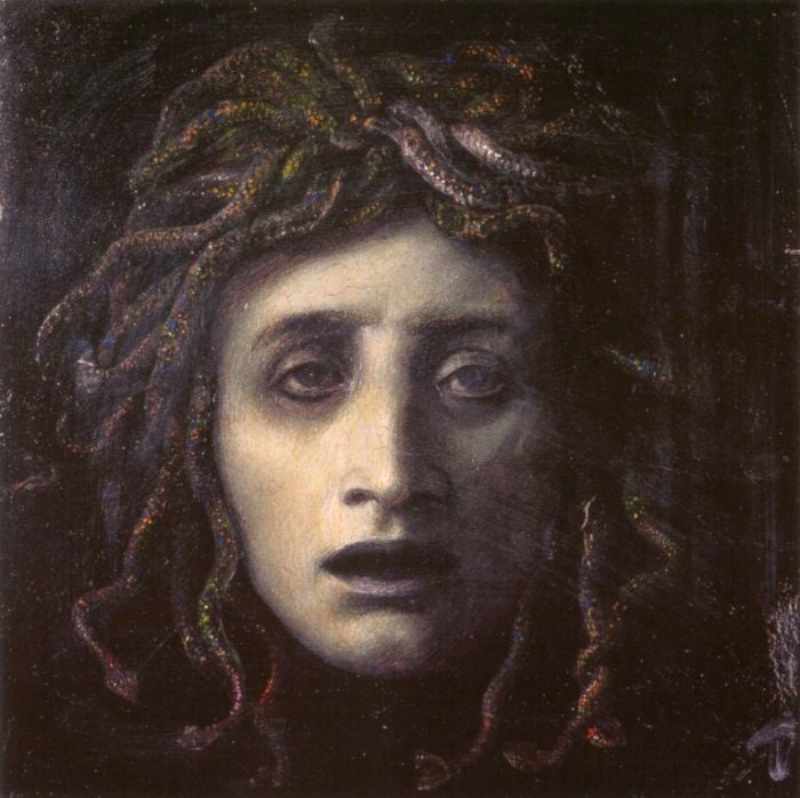In Greek mythology, Medusa, also called Gorgo, was one of the three monstrous Gorgons — Medusa, Stheno, and Euryale — generally described as winged human females with living venomous snakes in place of hair. Those who gazed into her eyes would turn to stone. Most sources describe her as the daughter of Phorcys and Ceto, although the author Hyginus makes her the daughter of Gorgon and Ceto. Medusa was beheaded by the Greek hero Perseus, who then used her head, which retained its ability to turn onlookers to stone, as a weapon until he gave it to the goddess Athena to place on her shield. In classical antiquity, the image of the head of Medusa appeared in the evil-averting device known as the Gorgoneion. According to Hesiod and Aeschylus, she lived and died on Sarpedon, somewhere near Cisthene. The 2nd-century BC novelist Dionysios Skytobrachion puts her somewhere in Libya, where Herodotus had said the Berbers originated her myth as part of their religion.
| Alias Medusa |
| Real Names/Alt Names Medusa |
| Characteristics Myths & Legends, Disembodied Body Part, Monster Mash, Reptile-themed, Stone-themed, Prehuman Epoch, Greek, Green-skinned |
| Creators/Key Contributors ○ |
| First Appearance Greek mythology |
| First Publisher ○ |
| Appearance List Literature: Homer’s Odyssey (c. 8th century BCE, English 1614), Homer’s Iliad (c. 8th century BC), Virgil’s Aeneid (29 to 19 BC), Metamorphoses (poem) by Ovid (8 CE), plays by Aeschylus, Sophocles, Euripides, Plato, Shakespeare, Dante Alighieri’s Divine Comedy (1308–1320), The Story of Greece: Told to Boys and Girls by Mary Macgregor (191-?) [Internet Archive], etc. Jumbo Comics #31, Pep Comics #46, The Beyond #8, Prize Comics #52, Ghost Comics #10, Eerie #8. Public Domain Appearances of Medusa’s Head: Captain Marvel Jr. #2, Thrilling Romances #12, Mystery Men Comics #24, Pep Comics #45, Yankee Comics #3, Bulls Eye Comics #11, Mister Mystery #15, Weird Terror #3, 7, Weird Horrors #5, Tomb of Terror #5. |
| Sample Read Bulfinch’s Mythology by Thomas Bulfinch [Internet Archive] |
| Description In Greek mythology, Medusa, also called Gorgo, was one of the three monstrous Gorgons — Medusa, Stheno, and Euryale — generally described as winged human females with living venomous snakes in place of hair. Those who gazed into her eyes would turn to stone. Most sources describe her as the daughter of Phorcys and Ceto, although the author Hyginus makes her the daughter of Gorgon and Ceto. Medusa was beheaded by the Greek hero Perseus, who then used her head, which retained its ability to turn onlookers to stone, as a weapon until he gave it to the goddess Athena to place on her shield. In classical antiquity, the image of the head of Medusa appeared in the evil-averting device known as the Gorgoneion. According to Hesiod and Aeschylus, she lived and died on Sarpedon, somewhere near Cisthene. The 2nd-century BC novelist Dionysios Skytobrachion puts her somewhere in Libya, where Herodotus had said the Berbers originated her myth as part of their religion. |
| Source Medusa – Wikipedia |


